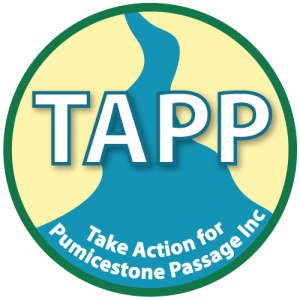Workshop Session 1 – Marine Group (Facilitator Jess Mowat)
- Where are the marine habitats?
- Need mapping
- Physical habitat & food source
- What did we have/ baseline data?
- 1982 WQ Plan shows the Passage was already impacted at that time.
- How is it changing? Rate of change?
- Confirm biodiversity of species
- What we know- 3 years of mapping fish species in south Passage & 2 years of mapping fish species in north Passage (University of Sunshine Coast PhD projects).
- What is the impact of recreational fishing?
- Are the protected areas in the right place?
- Central database needed to store & connect all the data.
- Need to better understand the impact on biodiversity of changes in hydrology (J.Larsen 2007).
- Better shorebird management
- More research/monitoring of high tide shorebird roosts
- Maroochy River wetlands – progression to tidal wetlands & gain in habitat
- Better education & enforcement of regulations to protect shorebirds needed e.g. dogs off leash
- Restrict access to roosts
- Increase habitat, roosting areas & food sources
- Greater understanding of the whole food web and interconnections
- Are there enough rangers?
- Revenue raising for better management – Fishing License (fee to fish) & fee to visit a National Park
- What are we using as a baseline data?
- Current focus is on high ecological value catchment while ignoring other catchments
- Shellfish reefs
- Need to better promote community campaigns e.g. Ozfish & help advertise for new recruits
- Litter awareness campaign e.g. Night eyes
- Central hub needed for community groups e.g. Health Land and Water (HLW)
- Local government could have a branch to coordinate community groups
- How do we reconcile use v protection when it comes to jetskis, 4WDs etc.
- Education & behaviour change needed
- 4WD Management Plan with designated roads
- Beach access points
- Permits should eb required to drive on beach
- Need to understand the full impact of jetskis e.g. on animals, erosion etc.
- Jetskis not compatible with Ramsar values
- 4WD and turtles not compatible
- Speed limits should be enforced across the Passage
- Better signage
- Impact of climate change on mangroves
- Citizen science on mangrove monitoring
- What is the impact of soft groins on seagrass
- Priority to map inter/sub tidal areas
- Benthic invertebrates -need more research
- Need well mapped, modelled & ground truthed study showing sustainable use of area
Workshop Session 2 – Marine Group – Geographical Areas
Area 1
- Shorebird habitat mapping
- Ban hovercraft
- Impact of rock groins
- Fish habitat zone study
- Modify stormwater drains to reduce algal blooms
Area 2
- Speed restrictions
- Cultural knowledge e.g. midden mapping
- More monitoring of biodiversity e.g. dugong & water mouse
- Fish permits or license to fund marine reserves & enforcement
- Reduce wash from wakes
- Shorebird roost mapping (MBRC currently mapping southern passage)
- More monitoring of saltmarsh community
- Understand hydrology of Tripcony Bight
- Promote fauna & flora reserve under the Commonwealth
Area 3 & 4
- 4WD Management Plan including stopping access during turtle nesting season
- Off road cycle paths
- Promote passive recreation e.g. a Great walk
- Geomorphology & hydrology studies by Mal Cox
Area 5
- Litter & $WD
- Consistency in planning for the area between councils
- Significant indigenous pathways
- Noise pollution – educations and restrict use
- Building environmental corridors
- Environmental controls of Beerwah East- need baseline studies
Area 6
- Education on the value of agricultural land
- Protection of good quality agricultural soil
- Land for wildlife of farms e.g fence off creeks, biocontrols, nest boxes
Area 7
- Land use planning for failed forestry land e.g. reserve & restoration
- Sewage treatment upgrades – populations and wastewater concerns
- Potable reuse of water
- Exhaust from poultry farms – emission controls needed
